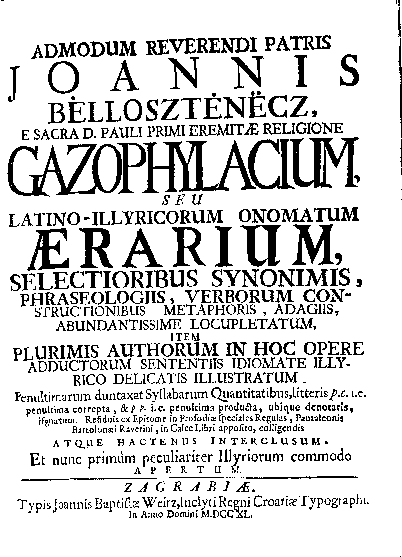Warning: you might want to skip this chapter and the following ones in the first reading. It introduces some advanced topics.
What are dialects? There's no simple answer, but everyone seems to understand the concept. They are different varieties that are hidden under one "umbrella" language.
So, in a perfect world, there would be discrete languages, and they would be internally divided into dialects. Surely, in a border area between two languages, a dialect could have some characteristics of the neighbor language. Well it is so maybe if we discuss Hungarian, a language that's surrounded with completely unrelated and unintelligible languages, but in the case of Croatian it's very far from the actual situation.
Is it necessary to have any knowledge of Croatian dialects? Well, yes. Not really to be able to speak them (but it would be immensely appreciated if you, e.g. try to move to a particular region of Croatia) but to have some idea and understanding of them, because they are actually used much. People actually use them. Actually, everyone mostly uses a mix of the Standard and dialect. This table summarizes what I mean:
dialect mostly dialect + some Standard some dialect + mostly Standard Standard people at home, local pubs, shops; poetry, traditional and pop songs ordinary people in public, at office; pop songs; forums "educated" people in public, politicians, government; local radio stations; songs, novels professional speakers on TV and radio
For instance, most movies feature some mix of dialect and standard, and a few of them were mostly in dialect: no subtitles were supplied, you were on your own and had to learn unknown words the hard way, by guessing their meaning.
How many distinct dialects are there? Well, there's no clear answer. To explain the complicated situation we need to look at a wider picture of "Western South Slavic dialects" (WSS) — that is, all dialects/speeches from Austrian and Italian border with Slovenia, all the way east to Southern Serbia.
Some dialects are spoken by only one ethnic group, others by up to four! For example, Croats speak at least 9 different dialects. The dialects spoken are usually grouped into Slovenian, Kajkavian, Čakavian, and Štokavian, but that grouping actually hides the real diversity, it's actually a bit more complex than that.
So what are Slovenian, Croatian, Serbian etc. languages? They are standards roughly based on a dialect, with some arbitrary and artificial additions.
Since all standards (except Slovenian) are based on fairly similar dialects, usually there's no need to translate between the Standard languages — I can read any book written in Bosnian or Serbian (but there are some differences in legal, scientific etc. terms). It's a bit harder with Slovenian for me (and speaking with the proper accent is out of question). But it's much easier for speakers of Kajkavian dialects. It's a matter of dispute where the Kajkavian dialects end and the Slovene begin...
Should one disregard dialects as uneducated, rural speech, and concentrate on the Standard? Not completely. First, because they appeal to emotions, songs frequently include some dialect. In fact, the bulk of Croatian pop is in dialect, mainly Southeastern Čakavian and Ikavian Neoštokavian. For instance, a quite popular tune, Galeb i ja "Seagull and me" is completely in dialect; here I quote a part of it:
Ča sve vaja, u svom bisu
Da i more vrije, pini
Bit gospodar, usrid svega
Živo klicat, u visini!
U visini kada Sunce
Bez pristanka nama sije
I da ništa na tvom nebu
I na moru bisno nije.
A... moj galebe
(Tomislav Zuppa)
The very first word, ča, does not exist in the Standard, and in fact the Čakavian dialects are named after it (it means "what"). Again, translation is not provided, you have to know that in this song pristanak does not mean "approval" as in Standard, but "end, cessation" (Standard: prëstanak); likewise for bis, usrid vs. Standard bijës, usrëd, and so on. It's not uncommon to find people asking on the internet what some word means; Croatian pop is quite popular in neighboring countries as well, where some fine points of dialects are not really known.
But there's another, more subtle reason. Here are front pages of some old books:



These are (from the left) the first printed novel in Croatian (Zoranić: Planine), published in year 1569; a five-language dictionary (Latin, Italian, Croatian, Hungarian, German) published in 1595, and a huge Latin-Croatian dictionary published in 1740, but actually written a century earlier. And all these works are in various dialects, not in the today Standard or some early version of it. Even in the 20th century a major work of Croatian literature was written in the Kajkavian dialect (Balade Petrice Kerempuha). Croatian dialects actually invoke "past glory" and late medieval culture; they were (and still are) speeches of advanced towns in Croatia, particularly on the coast. The story how the today Standard was selected is too complicated to explain here — a mix of history and politics, as one can expect.
So, the dialects in Croatia are not commonly associated with illiterate and ignorant peasants; the only way of escaping them is limiting oneself to TV news on the public TV. If you want to read older Croatian literature, you cannot escape it either. Therefore, I'll explain features of major dialects.
Beware, dialects differ in sounds, stress, details of grammar such as number of cases; in various case and verb endings, number of tenses; in some basic vocabulary including pronouns, etc. The differences are larger than e.g. between the Ukrainian and the Russian language! Yeah, you could have chosen some other language, but now it's too late.
Updated 2013-06-20 (v. 0.4)
No comments:
Post a Comment